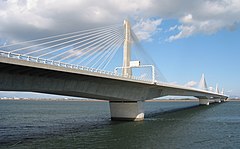Extradosed bridge

|
|
| Ancestor | Box girder bridge, cable-stayed bridge |
|---|---|
| Related | Low-tower cable-stayed |
| Descendant | none |
| Carries | Pedestrians, vehicles, light rail, heavy rail |
| Span range | Medium |
| Material | Concrete |
| Movable | No |
| Design effort | High |
| Falsework required | no |
An extradosed bridge employs a structure which combines the main elements of both a prestressed box girder bridge and a cable-stayed bridge. The name comes from the word , the exterior or upper curve of an arch, and refers to how the "stay cables" on an extradosed bridge are not considered as such in the design, but are instead treated as external prestressing tendons deviating upward from the deck. In this concept they remain part of, (and define the upper limit of), the main bridge superstructure.
Compared to a cable-stayed or cantilever-girder bridge of comparable span, an extradosed bridge uses much shorter stay-towers or pylons than the cable-stayed bridge, and a significantly shallower deck/girder structure than used on the girder bridge. This arrangement results in the typical extradosed "look" of a fan of low, shallow-angle stay cables, usually with a pronounced "open window" region extending from the sides of each tower.
The extradosal bridge form is mostly suited to medium-length spans between 100 metres (330 ft) and 250 metres (820 ft), and over fifty such bridges had been constructed around the world to 2012. Whilst incurring many of the construction costs of both the cable-stayed and girder bridge types, extradosed bridges can deliver material savings to offset much of this penalty. They have frequently been adopted when overall height, navigation clearance, or aesthetic requirements have made the cable-stayed or girder alternatives less feasible.
The earliest bridge known to incorporate some of the features of an extradosed design is the Ganter Bridge, constructed in Switzerland in 1980. Designed by Christian Menn of Zurich, it preceded by several years the 1988 publication on the design philosophy of such bridges by Jacques Mathivat, who is credited with inventing the extradosed terminology and its design concepts. The Ganter Bridge is a modified prestressed concrete cantilever girder design, where the longitudinal "continuity" tendons are raised significantly above the deck height at the ends of each main span and supported on short towers. These tendons are encased in fin-like blade walls on each side of the towers for protection, a design arrangement now often referred to as a cable-panel bridge.
Whilst little is known of the origin of Menn's design, Mathivat developed a theoretical basis for such a concept during 1982-1983 while preparing a tender proposal for the Autoroute A64 viaduct across Arret-Darre in France. Mathivat's design replaced the internal tendons normally located in the top of the box girder with "external" tendons running at a shallow angle from the deck surface in one span up over short towers and back to the next span. These he called extradosed tendons, as they connected to the extradose (or upper surface) of the bridge's spanning structure. The shallow angle of these tendons resulted in them transmitting a large compression force component into the bridge deck structure, allowing them to function in a similar manner to conventional "flexural" bridge prestressing. The extradosed tendons were continuous over the towers and were stressed from the deck level, unlike stay cables which normally terminate at the top of each pylon.
...
Wikipedia
